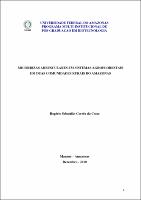| ???jsp.display-item.social.title??? |


|
Please use this identifier to cite or link to this item:
https://tede.ufam.edu.br/handle/tede/3078| ???metadata.dc.type???: | Tese |
| Title: | Micorrizas arbusculares em sistemas agroflorestais em duas comunidades rurais do Amazonas |
| ???metadata.dc.creator???: | Costa, Rogério Sebastião Corrêa da  |
| ???metadata.dc.contributor.advisor1???: | Oliveira, Luiz Antonio de |
| ???metadata.dc.description.resumo???: | As áreas desmatadas na Amazônia ocupam mais de 70 milhões de hectares, a maioria em estádios avançados de degradação. Aliado a isso, maioria dos solos apresenta acidez elevada e alta saturação com alumínio, o que limita os seus usos na agricultura regional. Uma alternativa eficiente para o uso dos solos é a utilização de microrganismos do solo visando um melhor aproveitamento dos nutrientes pelas plantas. Os fungos micorrízicos arbusculares aumentam a capacidade da planta de absorver nutrientes do solo e água, favorecendo sua nutrição. Os Sistemas Agroflorestais tem por base se aproximar da estrutura e dinâmica de uma floresta natural. O objetivo deste trabalho foi avaliar as interações micorrízicas na rizosfera das plantas de dois Sistemas Agroflorestais. Foram analisadas as interações entre as características químicas e físicas do solo e foliares com as variáveis micorrízicas em espécies componentes de dois Sistemas Agroflorestais, em épocas e localidades distintas. A colonização radicular por fungos micorrízicos arbusculares variou de 6,8 a 99,6 % nas plantas do SAF da comunidade do Brasileirinho e de 0,4 a 52,4% no SAF da comunidade de São Miguel. As hifas predominaram nas raízes de todas as espécies, respondendo entre 80 a 100 % das estruturas fúngicas observadas, em ambos os SAFs. Os arbúsculos, no SAF do Brasileirinho, foi a estrutura micorrízica que mais se correlacionou com os teores de nutrientes rizosféricos e foliares. O pH rizosférico, em ambos os SAFs, foi o componente do solo que mais influenciou as variáveis micorrízicas, correlacionando tanto positivamente como negativamente com a estruturas micorrízicas. O Fe presente no solo rizosférico, em ambos os SAF, foi o elemento que mais influenciou as relações nutrientes-micorrizas em todas as espécies. Os nutrientes foliares que mais se relacionaram com os FMA foram os teores de magnésio e potássio no SAF do Brasileirinho e fósforo e cálcio no SAF de São Miguel |
| Abstract: | The deforested areas in the Amazonia occupy more than 70 million hectares, the majority in advanced stage of degradation. Allied to this, the majority of the soils present high acidity and high aluminum saturation, which limits its uses in the regional agriculture. An efficient alternative for soil utilization is the use of soil microorganisms aiming at a better exploitation of the nutrients for the plants. The arbuscular mycorrhizal fungi (AMF) increase the capacity of the plant to absorb water and nutrients of the soil favoring its nutrition. The Agroforestry Systems have for base, to approach the structure and dynamics of a natural forest. The objective of this study was to evaluate the mycorrhizal interactions in the plant rhizosphere of two Agroforestry Systems. The interactions among chemical and physical characteristics of the soil and leaves nutrients with the mycorrhizal variable in component species of two Agroforestry Systems (AFs) were analyzed at distinct times and localities. Roots colonization by arbuscular mycorrhizae fungi ranged from 6.8 to 99.6% on plants of AFS in the Brasileirinho community and 0.4 to 52.4% in the AFS in the São Miguel community. Hyphae predominated in the roots of all the species, with 80 to 100% of the observed fungal structures, in both the AFs. The arbuscules, in the Agroforestry System of the Brasileirinho, were the mycorrhizal structure that more was correlated with rhizospheric and leaves nutrients cntents. The rhizospheric pH, in both the AFs, was the component of the soil that more influenced the mycorrhiza variables, correlating in such a way positively as negative with the mycorrhizal structures. The Fe in the rhizospheric soil, in both the AFSs, was the element that more influenced the nutrients-mycorrhiza relations in all the species. The leaves nutrients that were more related with the AMF were the Mg and K in the AF of the Brasileirinho and P and Ca in the AFS of São Miguel |
| Keywords: | Rizosfera Nutrição de plantas Latossolos Sazonalidade Amazônia Rhizosphere Plant nutrition Oxisols Seasonality Amazon |
| ???metadata.dc.subject.cnpq???: | CIÊNCIAS BIOLÓGICAS |
| Language: | por |
| ???metadata.dc.publisher.country???: | BR |
| Publisher: | Universidade Federal do Amazonas |
| ???metadata.dc.publisher.initials???: | UFAM |
| ???metadata.dc.publisher.department???: | Instituto de Ciências Biológicas |
| ???metadata.dc.publisher.program???: | Programa de Pós-Graduação em Biotecnologia |
| Citation: | COSTA, Rogério Sebastião Corrêa da. Micorrizas arbusculares em sistemas agroflorestais em duas comunidades rurais do Amazonas. 2010. 155 f. Tese (Doutorado em Biotecnologia) - Universidade Federal do Amazonas, Manaus, 2010. |
| ???metadata.dc.rights???: | Acesso Aberto |
| URI: | http://tede.ufam.edu.br/handle/tede/3078 |
| Issue Date: | 10-Dec-2010 |
| Appears in Collections: | Doutorado em Biotecnologia |
Files in This Item:
| File | Description | Size | Format | |
|---|---|---|---|---|
| Rogerio Sebastiao Correa da Costa.pdf | 1.31 MB | Adobe PDF |  Download/Open Preview |
Items in DSpace are protected by copyright, with all rights reserved, unless otherwise indicated.




